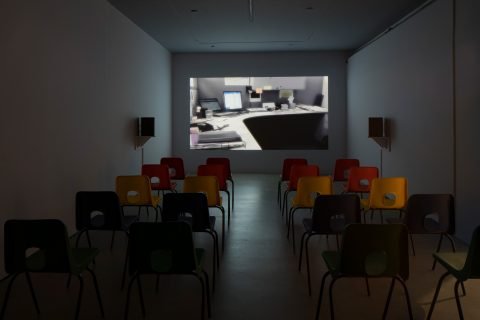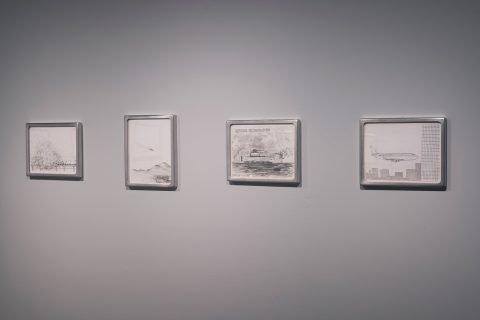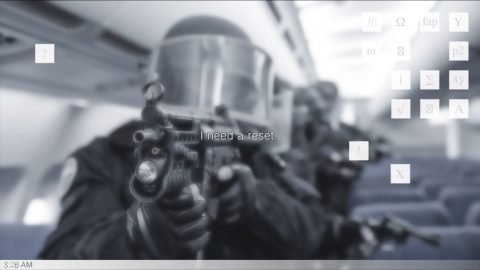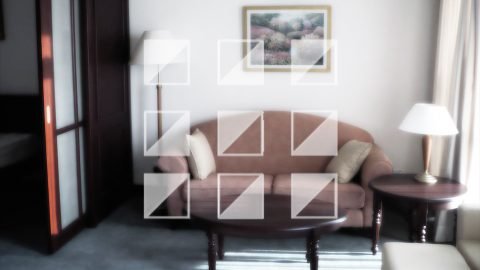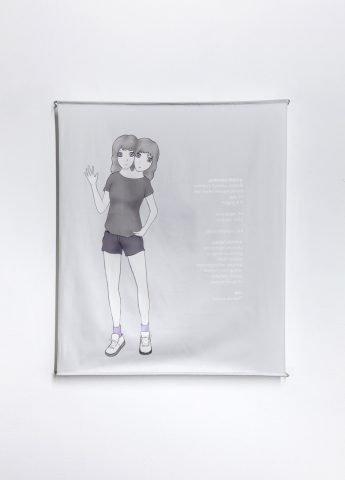On Andrea Crespo and the intergendered element
- Exhibition view: List Projects: Andrea Crespo, 2017. MIT List Visual Arts Center Cambridge, MA. Courtesy of the artist; Downs & Ross, New York; Kraupa-Tuskany Zeidler, Berlin.
- Exhibition view: List Projects: Andrea Crespo, 2017. MIT List Visual Arts Center Cambridge, MA. Courtesy of the artist; Downs & Ross, New York; Kraupa-Tuskany Zeidler, Berlin.
- Andrea Crespo,[intensifies], 2016 (film still), HD video, color, sound, 1:00:57. Courtesy of the artist; Downs & Ross, New York; Kraupa-Tuskany Zeidler, Berlin.
- Andrea Crespo,[intensifies], 2016 (film still), HD video, color, sound, 1:00:57. Courtesy of the artist; Downs & Ross, New York; Kraupa-Tuskany Zeidler, Berlin.
- Andrea Crespo, patient(s) history, 2015. Digital print on cotton sateen, 34 1⁄2 x 30 x 2 1⁄4 in. / 87 x 76 x 6 cm. Exhibition View: Swiss Institute / Contemporary Art, New York. Courtesy of the artist and Downs & Ross, New York.
If you happen to be in Cambridge, MA, only a few hours by train from New York, ‘List Project: Andrea Crespo’ at Mit List Visual Arts Center is worth a visit. The artist (born 1993 in Miami, living and working in Brooklyn) rose to public attention through their neurological embodiment as a point of inquiry as well as departure for a practice spanning video, drawing and sculpture. At the centre of the artist investigation, there is the debate about identity and queer politics; Crespo believe in alternative possibilities that go well beyond the aforementioned scopes. Issues about individuation hold an urgent aspect when one, as in the artist case, happens to be a “they”, the pronoun for many gender nonconforming people.
Symbiosis, community, inner conflict but also computational networking, posthumanism, the medical sciences and their systems of control are all on the table here and closely related to a personal narrative. At time, this is hard to pinpoint, being enigmatic and not tangible, as it exists in the future and in a rather precocius mind of an artist who has already showed in remarkable institutions such as the Whitney, the New Museum and the Fridericianum. But let’s go back to the show at the Mit. Our first encounter is with an hour long video [intensifies] (2016). The animated video features Alan, a fictional young autistic male aged six, subjected to a range of psychological tests and daily trials, largely inspired by the personal experience of the artist. Alan is socially struggling and cannot synchronize with their peers. We have no idea of how they look like as still images of rather surveillance inspired interiors function as backdrop for a story that unfolds through superimposed dialogues and evocative sounds. The video is showed along with twelve fascinating graphite drawings accompanied by custom, aeronatically-inspired frames. Both the film and drawings depict Alan’s machinic fantasies and a neurodivergent experience of the world expressed in images of transport, warfare and terror. They also engage with the theme of the changeling, a common motif in literature (think of Lionel Shriver’s “We need to talk about Kevin”, for example) and film (“Elephant” by Gus Van Sant) depicting the troubled adolescent, the demonic child or the disturbed loner. Alex Ross, director and founder of Hester Gallery who represents Andrea Crespo along with Kraupa-Tuskany Zeidler, says about the exhibition “As ever the works dually address and demonstrate restated engagements with how human subjects, and their cultural biases and biological characteristics, are apprehended by and incorporated into technological systems. New to these series is a marked extension of the imaginaries and compositional scope of Andrea’s practice – evident particularly in the presence of new protagonists: Alan and Andrea themselves”.
As it happens also with previous work by the artist, a clinical aesthetic (post internet, one would argue) is predominant but never dry and cold, while it is poetic and touching in its algorithmic language. Ross carries on by saying “in both cases, it feels especially pressing to see their earlier narratives of neurodivergence now encompass the linkage between networked medical sciences and global surveillance policies. The drawings, too, pursue the video’s protagonist during his quasi-mechanic fixations as a cipher for the mediatization of autism as a source of weaponized neural patterns at a time of heightened international alarm and systemized political exclusions”. A very important work by Andrea Crespo is to be inaugurated by Ross new gallery Downs & Ross on March 19th, and the video – their first feature-length animation – will be co-presented with the New Museum, which is organizing a panel around it for mid-April. A great opportunity to meditate on their art and the mystery of identity, “reminding us that the self is even more otherwordly than we fear it is” (Dodie Bellamy on the art of Andrea Crespo, Frieze n.184, 2017).
February 20, 2017

